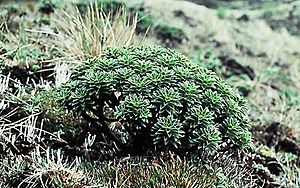Wai'ale'ale dubautia facts for kids
Quick facts for kids Wai'ale'ale dubautia |
|
|---|---|
 |
|
| Conservation status | |
| Scientific classification | |
| Kingdom: | |
| (unranked): | |
| (unranked): | |
| (unranked): | |
| Order: | |
| Family: | |
| Genus: | |
| Species: |
D. waialealae
|
| Binomial name | |
| Dubautia waialealae |
|
Dubautia waialealae is a very special and rare flowering plant. It belongs to the aster family, which also includes sunflowers and daisies. People often call it the Wai'ale'ale dubautia. In Hawaii, like other plants in its group, it is known as na`ena`e.
Where Does This Plant Live?
Dubautia waialealae is an endemic plant. This means it grows naturally in only one place in the world. For this plant, that place is Hawaii. You can only find it on Mount Waiʻaleʻale on the island of Kauai.
Scientists once saw one plant about 14 kilometers away. However, that plant is no longer alive. Today, there are about 3,000 of these plants left. They live in a very wet, boggy forest habitat. This area on Mount Waiʻaleʻale is one of the rainiest places on Earth!
The plant grows near the famous Mount Waiʻaleʻale rain gauge. This gauge measures how much rain falls. On average, it gets about 460 inches (or 38.3 feet) of rain each year. The plants grow around this spot and a little way down the mountain slopes.
What Does the Wai'ale'ale Dubautia Look Like?
Dubautia waialealae is a unique plant. It is part of a group called the silversword alliance. This plant grows into a thick, rounded, cushion-like shape. It can be anywhere from 10 to 50 centimeters tall.
Its leaves grow in tight circles, close together. The plant produces yellow flowers. These flowers grow in special groups called heads. You can usually see these plants blooming from August through November.
Why Is This Plant Endangered?
Dubautia waialealae is a very rare plant. It is considered an endangered species in the United States. This means it is at high risk of disappearing forever.
Several things threaten this special plant. Feral pigs and feral goats can damage its habitat. They might eat the plants or disturb the soil. Also, invasive plant species are a big problem. Plants like Juncus planifolius and Andropogon virginicus can grow quickly. They take over the space and resources that Dubautia waialealae needs to survive.
Because of these threats, the plant was officially listed as endangered in 2010. This listing helps protect it and its home.


